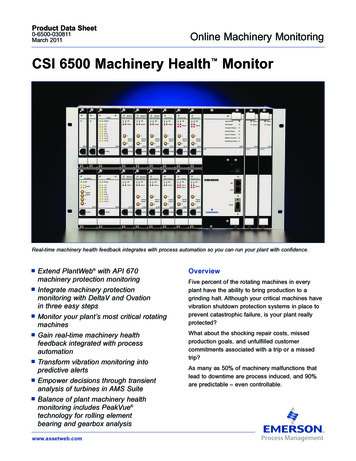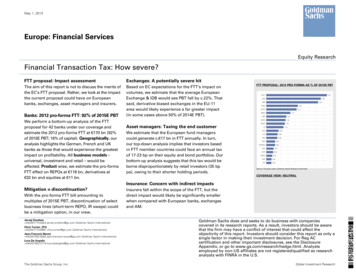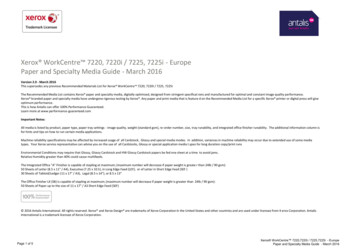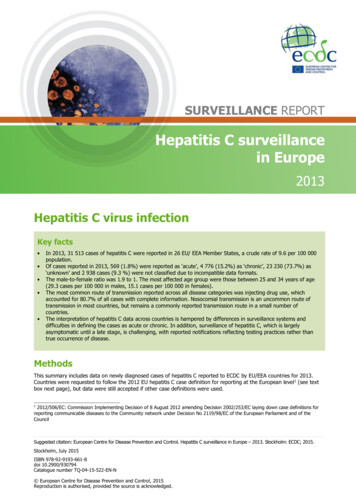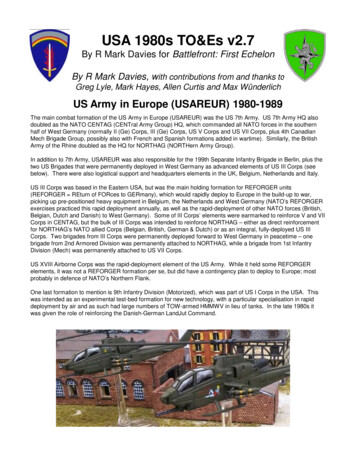
Transcription
USA 1980s TO&Es v2.7By R Mark Davies for Battlefront: First EchelonBy R Mark Davies, with contributions from and thanks toGreg Lyle, Mark Hayes, Allen Curtis and Max WünderlichUS Army in Europe (USAREUR) 1980-1989The main combat formation of the US Army in Europe (USAREUR) was the US 7th Army. US 7th Army HQ alsodoubled as the NATO CENTAG (CENTral Army Group) HQ, which commanded all NATO forces in the southernhalf of West Germany (normally II (Ge) Corps, III (Ge) Corps, US V Corps and US VII Corps, plus 4th CanadianMech Brigade Group, possibly also with French and Spanish formations added in wartime). Similarly, the BritishArmy of the Rhine doubled as the HQ for NORTHAG (NORTHern Army Group).In addition to 7th Army, USAREUR was also responsible for the 199th Separate Infantry Brigade in Berlin, plus thetwo US Brigades that were permanently deployed in West Germany as advanced elements of US III Corps (seebelow). There were also logistical support and headquarters elements in the UK, Belgium, Netherlands and Italy.US III Corps was based in the Eastern USA, but was the main holding formation for REFORGER units(REFORGER REturn of FORces to GERmany), which would rapidly deploy to Europe in the build-up to war,picking up pre-positioned heavy equipment in Belgium, the Netherlands and West Germany (NATO’s REFORGERexercises practiced this rapid deployment annually, as well as the rapid-deployment of other NATO forces (British,Belgian, Dutch and Danish) to West Germany). Some of III Corps’ elements were earmarked to reinforce V and VIICorps in CENTAG, but the bulk of III Corps was intended to reinforce NORTHAG – either as direct reinforcementfor NORTHAG’s NATO allied Corps (Belgian, British, German & Dutch) or as an integral, fully-deployed US IIICorps. Two brigades from III Corps were permanently deployed forward to West Germany in peacetime – onebrigade from 2nd Armored Division was permanently attached to NORTHAG, while a brigade from 1st InfantryDivision (Mech) was permanently attached to US VII Corps.US XVIII Airborne Corps was the rapid-deployment element of the US Army. While it held some REFORGERelements, it was not a REFORGER formation per se, but did have a contingency plan to deploy to Europe; mostprobably in defence of NATO’s Northern Flank.One last formation to mention is 9th Infantry Division (Motorized), which was part of US I Corps in the USA. Thiswas intended as an experimental test-bed formation for new technology, with a particular specialisation in rapiddeployment by air and as such had large numbers of TOW-armed HMMWV in lieu of tanks. In the late 1980s itwas given the role of reinforcing the Danish-German LandJut Command.
US Army in Europe (USAREUR)US III Corps (a)US 7th Army (CENTAG)US XVIII (Airborne) Corps (a)US V CorpsBATTLEGROUP CWUS-289th Infantry Division (Motorized) (g)US VII CorpsBATTLEGROUP CWUS-11199th Infantry Brigade (Berlin Brigade) (e)II (Ge) Corps (b)BATTLEGROUP CWUS-173-325th Parachute Infantry Battalion (ef)III (Ge) Corps (b)Southern Territorial Command (bc)ARMY TROOPS10th ADA Brigade (d)69th ADA Brigade (d)94th ADA Brigade (d)108th ADA Brigade (d)(a) These formations were stationed in the USA, but were readyto reinforce USAREUR. However, their most likely destinationwould have been the British-led NORTHAG sector rather thanCENTAG.56th Pershing Brigade(b) Two regular German Corps and the Corps-sized SouthernTerritorial Command came under command of CENTAG.18th Engineer Brigade(c) Although not part of the CENTAG command structure forvarious political reasons, the French II Corps was partially locatedwithin CENTAG’s area of responsibility, with I Corps in reserve,just over the border. It is likely that one or both of theseformations might have come under command of CENTAG in theevent of war. Another option was for the creation of a newSOUTHAG, led by the French 1st Army Headquarters. Thiswould comprise both French Corps and III (Ge) Corps, plus onedivision from the German Southern Territorial Command.1-10th Special Forces BattalionI (Fr) Corps (c)II (Fr) Corps (c)BATTLEGROUP CWSP-01Spanish 1st ‘Brunete’Armoured Division(d) These units formed the 32nd Air Defence Command and werearmed with I-Hawk SAMs (progressively replaced with PatriotSAMs in the late 1980s).(e) These units, while part of USAREUR, did not come under theCENTAG command structure.(f) This unit was stationed in Italy as a rapid-response unit forNATO’s LANDSOUTH Command (see the Italian TO&Es).Additionally and long with British, Belgian and German units, itwould have formed part of the ACE Mobile Force (Land) SouthernOption.(g) This formation was assigned in the late 1980s to reinforce theDanish-German LandJut Corps.
US V CorpsUS VII CorpsBATTLEGROUP CWUS-01BATTLEGROUP CWUS-013rd Armored Division1st Armored DivisionBATTLEGROUP CWUS-02BATTLEGROUP CWUS-028th Infantry Division (Mech)3rd Infantry Division (Mech)BATTLEGROUP CWUS-12BATTLEGROUP CWUS-1211th Armored Cavalry Regiment2nd Armored Cavalry RegimentBATTLEGROUP CWUS-27BATTLEGROUP CWUS-2712th Combat Aviation Brigade11th Combat Aviation Brigade41st Field Artillery Brigade17th Field Artillery Brigade42nd Field Artillery Brigade72nd Field Artillery Brigade130th Engineer Brigade210th Field Artillery Brigade7th Engineer BrigadeBATTLEGROUP CWUS-033rd Brigade, 1st Infantry Division(Forward-Deployed element from III Corps)BATTLEGROUP CWCA-014th Canadian Mechanised Brigade GroupAlternative:BATTLEGROUP1st Canadian Infantry Division(From 1988)
US III CorpsBATTLEGROUP CWUS-012nd Armored Division(REFORGER to NORTHAG – 1 Bde pre-positioned)US XVIII Airborne CorpsBATTLEGROUP CWUS-0482nd Airborne DivisionBATTLEGROUP CWUS-01BATTLEGROUP CWUS-051st Cavalry Division101st Airborne Division(Air Assault)(REFORGER to NORTHAG)BATTLEGROUP CWUS-021st Infantry Division (Mech)(REFORGER to VII Corps – 1 Bde pre-positioned)BATTLEGROUP CWUS-02BATTLEGROUP CWUS-0610th (Mountain) LightInfantry Division (a)4th Infantry Division (Mech)BATTLEGROUP CWUS-02(REFORGER to V Corps)24th Infantry Division (Mech)BATTLEGROUP CWUS-025th Infantry Division (Mech)(REFORGER to NORTHAG)(REFORGER formation)BATTLEGROUP CWUS-2718th Combat Aviation BrigadeBATTLEGROUP CWUS-123rd Armored Cavalry Regiment18th Field Artillery Brigade (Airborne)(REFORGER to NORTHAG)BATTLEGROUP CWUS-2712th Cavalry Brigade (Air Combat)75th Field Artillery Brigade212th Field Artillery Brigade(REFORGER to NORTHAG)214th Field Artillery Brigade31st Air Defense Artillery Brigade20th Engineer Brigade6th Air Defense Artillery Brigade11th Air Defense Artillery Brigade(a) 10th Mountain Division was added in 1986.
BATTLEGROUP CWUS-01(a) The 1st Cavalry Division (a REFORGER formationassigned to III Corps in the USA) was simply an ArmoredDivision with a historical title. Many of its constituent Armoredand Mech Infantry Battalions were converted from old CavalryRegiments and similarly retained the historical title of ‘Cavalry’,even though they didn’t function as reconnaissance troops.US Armored Division 1980sBATTLEGROUP CWUS-01US Cavalry Division 1980s (a)BATTLEGROUPS (BRIGADE HEADQUARTERS)BG CWUS-03x3 Heavy Brigade Headquarters (bcd)HQCommandx1 CommanderCWUS-36Transportx1 M577 Armoured Command VehicleCWUS-14BG CWUS-03Up to x1 Aviation Brigade Headquarters (bcd)HQCommandx1 CommanderCWUS-36Transportx1 M577 Armoured Command VehicleCWUS-14BATTLEGROUPS (MANEUVER BATTALIONS) (e)BG CWUS-13x6 Armored Battalion (e)BG CWUS-14x5 or x4 Mechanized Infantry Battalion (ef)BG CWUS-16x1 Divisional Armored Cavalry Squadron (en)MANOEUVRE ELEMENTS(b) Brigades within a division were normally numbered 1st,2nd or 3rd Brigades of a particular division. ‘CombatManeuver Battalions’ (i.e. Armor or Mech Infantry) were thendistributed to the Brigades as required by the tactical situation.An Armored Division initially had x6 Armored and x5 MechInfantry Battalions. However, one Mech Infantry Battalionwas deleted under the ‘Division 86’ reorganisation, which gaveArmoured Divisions x6 Armoured and x4 Mech InfantryBattalions.(c) Generally only Independent (‘Separate’ in US parlance)Brigades would be assigned ‘Armored’ or ‘Mechanised’designations and individual numbers. However, the exceptionto this rule was National Guard Brigades assigned toREFORGER divisions, which would come with their own unitidentity (e.g. ‘48th Mech Infantry Brigade, Georgia NationalGuard’ would become ‘3rd Brigade, 24th Infantry Division’ inwartime). However, all this was academic in wartime, as unitswould get quickly mixed up as battlegroups would be formed,dispersed and then re-formed as the mission dictated.(d) A 4th (Aviation) Brigade was formed in each division aspart of the ‘Division 86’ reorganisation. In peacetime the 4th(Aviation) Brigade held administrative responsibility for theDivisional Armoured Cavalry Squadron and the division’saviation assets. However, in wartime the brigade wouldfunction like any other in the division and would share, mix andmatch the division’s Combat Maneuver Battalions, CavalrySquadron and aviation assets as required by the tacticalsituation.ME CWUS-16x4 Combat Engineer Company (el)(e) These elements were distributed among the division’sbrigades as required.ME CWUS-17x3 Air Defence Battery (Vulcan) (e)(f) x1 Mech Infantry Battalion was deleted under the ‘Division86’ reorganisation (see above).ME CWUS-18x3 Air Defence Battery (Chaparral) (e)(g) Mid-1980s: Heavy Artillery Battalions were all massed inthe Corps Artillery Brigades (x2 in each Corps – see FSECWUS-11). Replace with x1 MLRS Battery (FSE CWUS-10).FIRE SUPPORT ELEMENTS(h) Early-1980s: May replace AH-1S Cobra with:AH-1S Enhance Cobra Attack HelicopterFSE CWUS-01x3 SP Field Artillery Battalion (e)FSE CWUS-07x1 SP Heavy Artillery Battalion (eg)DIVISIONAL AVIATION ASSETS (dm)x20 AH-1S Cobra Attack Helicopter (ehi)CWUS-61x18 OH-58 Kiowa Observation Helicopter (ej) CWUS-57x10 UH-1D/H Iroquois Utility Helicopter (ek)CWUS-59CWUS-62(i) Late-1980s: May replace x10 AH-1S Cobra with:AH-64 Apache Attack HelicopterCWUS-65(j) Late-1980s: May replace x3 OH-58 Kiowa with:OH-58D Kiowa Warrior Observation Helicopter CWUS-58(k) From early 1980s: May replace x7 UH-1H/D Iroquois with:UH-60 Blackhawk Utility HelicopterCWUS-60(l) The divisional Combat Engineer Battalion also had aBridging Company not shown here. Each Corps also had aCombat Engineer Brigade of three battalions, plus twoadditional Bridging Companies.(m) Each Corps also had an independent Combat AviationBrigade (BG CWUS-27).(n) Each Corps also possessed an Armoured CavalryRegiment (BG CWUS-12).
BATTLEGROUP CWUS-02US Infantry Division (Mech) 1980sBATTLEGROUPS (BRIGADE HEADQUARTERS)BG CWUS-03x3 Heavy Brigade Headquarters (abc)HQCommandx1 CommanderCWUS-36Transportx1 M577 Armoured Command VehicleCWUS-14BG CWUS-03Up to x1 Aviation Brigade Headquarters (abc)HQCommandx1 CommanderCWUS-36Transportx1 M577 Armoured Command VehicleCWUS-14BATTLEGROUPS (MANEUVER BATTALIONS)BG CWUS-13x4 or x5 Armored Battalion (de)BG CWUS-14x6 or x5 Mechanized Infantry Battalion (df)BG CWUS-16x1 Divisional Armored Cavalry Squadron (el)MANOEUVRE ELEMENTS(a) Brigades within a division were simply numbered 1st, 2ndor 3rd Brigades of a particular division. ‘Combat ManeuverBattalions’ (i.e. Armor or Mech Infantry) were then distributedto the Brigades as required by the tactical situation. AnInfantry Division (Mech) initially had x4 Armored and x6 MechInfantry Battalions. However, x1 Mech Infantry Battalionwas replaced with x1 Armored Battalion under the ‘Division86’ reorganisation, which meant that the division now had x5Armoured and x5 Mech Infantry Battalions.(b) Generally only Independent (‘Separate’ in US parlance)Brigades would be assigned ‘Armored’ or ‘Mechanised’designations and individual numbers. However, the exceptionto this rule was National Guard Brigades assigned toREFORGER divisions, which would come with their own unitidentity (e.g. ‘48th Mech Infantry Brigade, Georgia NationalGuard’ would become ‘3rd Brigade, 24th Infantry Division’ inwartime). However, all this was academic in wartime, as unitswould get quickly mixed up as battlegroups would be formed,dispersed and then re-formed as the mission dictated.(c) A 4th (Aviation) Brigade was formed in each division aspart of the ‘Division 86’ reorganisation. In peacetime the 4th(Aviation) Brigade held administrative responsibility for theDivisional Armoured Cavalry Squadron and the division’saviation assets. However, in wartime the brigade wouldfunction like any other in the division and would share, mix andmatch the division’s Combat Maneuver Battalions, CavalrySquadron and aviation assets as required by the tacticalsituation.(d) These elements were distributed among the division’sbrigades as required.ME CWUS-16x4 Combat Engineer Company (dj)(e) x1 Armored Battalion was added during the ‘Division 86’reorganisation (see above).ME CWUS-17x3 Air Defence Battery (Vulcan) (d)(f) x1 Mech Infantry Battalion was deleted under the ‘Division86’ reorganisation (see above).ME CWUS-18x3 Air Defence Battery (Chaparral) (d)FIRE SUPPORT ELEMENTS(g) Mid-1980s: Heavy Artillery Battalions were all massed inthe Corps Artillery Brigades (x2 in each Corps – see FSECWUS-11). Replace with x1 MLRS Battery (FSE CWUS-10).FSE CWUS-01x3 SP Field Artillery Battalion (d)(h) Early-1980s: May replace AH-1S Cobra with:AH-1S Enhanced Cobra Attack HelicopterFSE CWUS-07x1 SP Heavy Artillery Battalion (dg)DIVISIONAL AVIATION ASSETS (ck)x20 AH-1S Cobra Attack Helicopter (dh)CWUS-61x18 OH-58 Kiowa Observation Helicopter (e) CWUS-57x10 UH-1D/H Iroquois Utility Helicopter (ej)CWUS-59CWUS-62(i) From early 1980s: May replace x7 UH-1H/D Iroquois with:UH-60 Blackhawk Utility HelicopterCWUS-60(j) The divisional Combat Engineer Battalion also had aBridging Company not shown here. Each Corps also had aCombat Engineer Brigade of three battalions, plus twoadditional Bridging Companies.(k) Each Corps also had an independent Combat AviationBrigade (BG CWUS-27).(l) Each Corps also possessed an Armoured CavalryRegiment (BG CWUS-12).
BATTLEGROUP CWUS-04US Airborne Division 1980s (a)BATTLEGROUPSBG CWUS-07x3 Airborne Brigade (bc)BG CWUS-19x1 Airborne Armored BattalionBG CWUS-20x1 Cavalry Squadron (Airborne) (c)MANOEUVRE ELEMENTSME CWUS-19x4 Combat Engineer Company (Light)ME CWUS-20x3 Air Defence Battery (Light)DIVISIONAL AVIATION ASSETS (cde)x9 AH-1S Cobra Attack Helicopter (efg)CWUS-61x15 OH-58 Kiowa Observation Helicopter (eh)CWUS-57x15 UH-1D/H Iroquois Utility Helicopter (ei)CWUS-59(a) While there were two US divisions designated as ‘Airborne’during the 1980s, only the 82nd Airborne Division was a true,traditional parachute formation. The 101st Airborne Divisionhad been reorganised as a heli-borne Air Assault Division (BGCWUS-05). These divisions formed a part of the US XVIIIAirborne Corps, along with 24th Infantry Division (Mech) (BGCWUS-02), two Separate REFORGER Heavy Brigades (BGCWUS-03 - 194th Armored Brigade and 197th Infantry Brigade(Mech)), a Combat Aviation Brigade consisting entirely ofobservation and transport helicopters, an Airborne Field ArtilleryBrigade (FSE CWUS-12), two Air Defence Brigades and anEngineer Brigade. The 10th Mountain Division (BG CWUS-06)was also added to XVIII Airborne Corps in 1986. 82nd AirborneDivision was not permanently assigned to Europe as aREFORGER division, but could be rapidly deployed anywhere,which of course, includes Europe. A battalion group could bedeployed within 24 hours, while a full brigade would take 3 daysto deploy. The whole division could be deployed anywherearound the globe within 10 days.(b) These brigades were also designated as regiments (325th,504th & 505th Parachute Infantry Regiments). However, inwartime the battalions could be mixed up and other units ofvarious types (e.g. Armored Battalions if operating in a groundrole) added from elsewhere, in which case the ‘Brigade’designation would be more appropriate than ‘Regiment’.(c) During the ‘Division 86’ reorganisations (as in the HeavyDivisions), a fourth (Aviation) Brigade was created from theheadquarters of the divisional Aviation element. In peacetimethis brigade contained all the divisional helicopters and theCavalry Squadron, but in wartime the division’s four brigadeswould all be mixed up as the tactical situation required.(d) Note that the Brigade HQs and the Cavalry Squadron eachhave their own integral helicopters, which are listed under thoseBGs.(e) Aviation assets may be distributed among the brigades asrequired.(f) Early-1980s: Replace AH-1S Cobra with:AH-1S Enhanced Cobra Attack HelicopterCWUS-62(g) Late 1980s: Replace all AH-1 Cobra types with:AH-64 Apache Attack HelicopterCWUS-65(h) Late-1980s: Replace x3 OH-58 Kiowa with:OH-58D Kiowa Warrior Observation HelicopterCWUS-58(i) Mid-1980s: Replace UH-1D/H Iroquois with:UH-60 Blackhawk Utility HelicopterCWUS-60
BATTLEGROUP CWUS-05US Air Assault Division 1980s (a)BATTLEGROUPSBG CWUS-08x3 Air Assault Brigade (bc)MANOEUVRE ELEMENTSME CWUS-19x4 Combat Engineer Company (Light)ME CWUS-20x3 Air Defence Battery (Light)DIVISIONAL AVIATION ASSETS (cde)x42 AH-1S Cobra Attack Helicopter (efg)CWUS-61x29 OH-58 Kiowa Observation Helicopter (eh)CWUS-57x39 UH-1D/H Iroquois Utility Helicopter (ei)CWUS-59(a) The 101st Airborne Division (Air Assault) had by the 1980s,long given up its parachutes for helicopters and had beenredesignated as ‘Air Assault’. Along with 82nd AirborneDivision, it formed a part of the US XVIII Airborne Corps, whichalso included 24th Infantry Division (Mech) (BG CWUS-02), twoSeparate REFORGER Heavy Brigades (BG CWUS-03 - 194thArmored Brigade and 197th Infantry Brigade (Mech)), a CombatAviation Brigade consisting entirely of observation and transporthelicopters, an Airborne Field Artillery Brigade (FSE CWUS-12),two Air Defence Brigades and an Engineer Brigade. The 10thMountain Division (BG CWUS-06) was also added to XVIIIAirborne Corps in 1986. 101st Airborne Division was notpermanently assigned to Europe as a REFORGER division, butcould be deployed by air anywhere, which of course, includesEurope. A brigade would take 10 days to deploy. The wholedivision could be deployed anywhere around the globe within 30days.x24 CH-47 Chinook Transport Helicopter (ej) CWUS-67(b) These brigades were also designated as regiments (187th,327th & 507th Air Assault Infantry Regiments). However, inwartime the battalions could be mixed up and other units ofvarious types (e.g. Armored Battalions if operating in a groundrole) added from elsewhere, in which case the ‘Brigade’designation would be more appropriate than ‘Regiment’.(c) During the ‘Division 86’ reorganisations (as in the HeavyDivisions), a fourth (Aviation) Brigade was created from theheadquarters of the divisional Aviation element. In peacetimethis brigade contained all the divisional helicopters, but inwartime the division’s four brigades would all be mixed up as thetactical situation required.(d) Note that the Brigade HQs each have their own integralhelicopters, which are listed under BG CWUS-08.(e) Aviation assets may be distributed among the brigades asrequired.(f) Mid-1980s: Reduce to x30 AH-1 Cobra. However, replaceAH-1S Cobra with:AH-1S Enhanced Cobra Attack HelicopterCWUS-62(g) Late 1980s: Replace x9 AH-1 Cobra types with:AH-64 Apache Attack HelicopterCWUS-65(h) Mid-1980s: Increase to x42 OH-58 Kiowa. Then during thelate-1980s: Replace x3 OH-58 Kiowa with:OH-58D Kiowa Warrior Observation Helicopter CWUS-58(i) Mid-1980s: Increase to x60 Utility Helicopters and replaceUH-1D/H Iroquois with:UH-60 Blackhawk Utility HelicopterCWUS-60(j) Mid-1980s: Reduce to x12 CH-47 Chinook Heavy TransportHelicopters.
BATTLEGROUP CWUS-06US Light Infantry Division 1980s (ab)BATTLEGROUPSBG CWUS-09x3 Light Infantry Brigade (c)BG CWUS-22x1 Cavalry Squadron (Light) (c)MANOEUVRE ELEMENTS(a) The US Light Infantry Division was a brand-new concept thatappeared in the mid-1980s and utilised the light mobilitycapability offered by the new M998 HMMWV utility vehicle. Theonly such formation
USA 1980s TO&Es v2.7 By R Mark Davies for Battlefront: First Echelon By R Mark Davies, with contributions from and thanks to Greg Lyle, Mark Hayes, Allen Curtis and Max Wünderlich The main combat formatio
